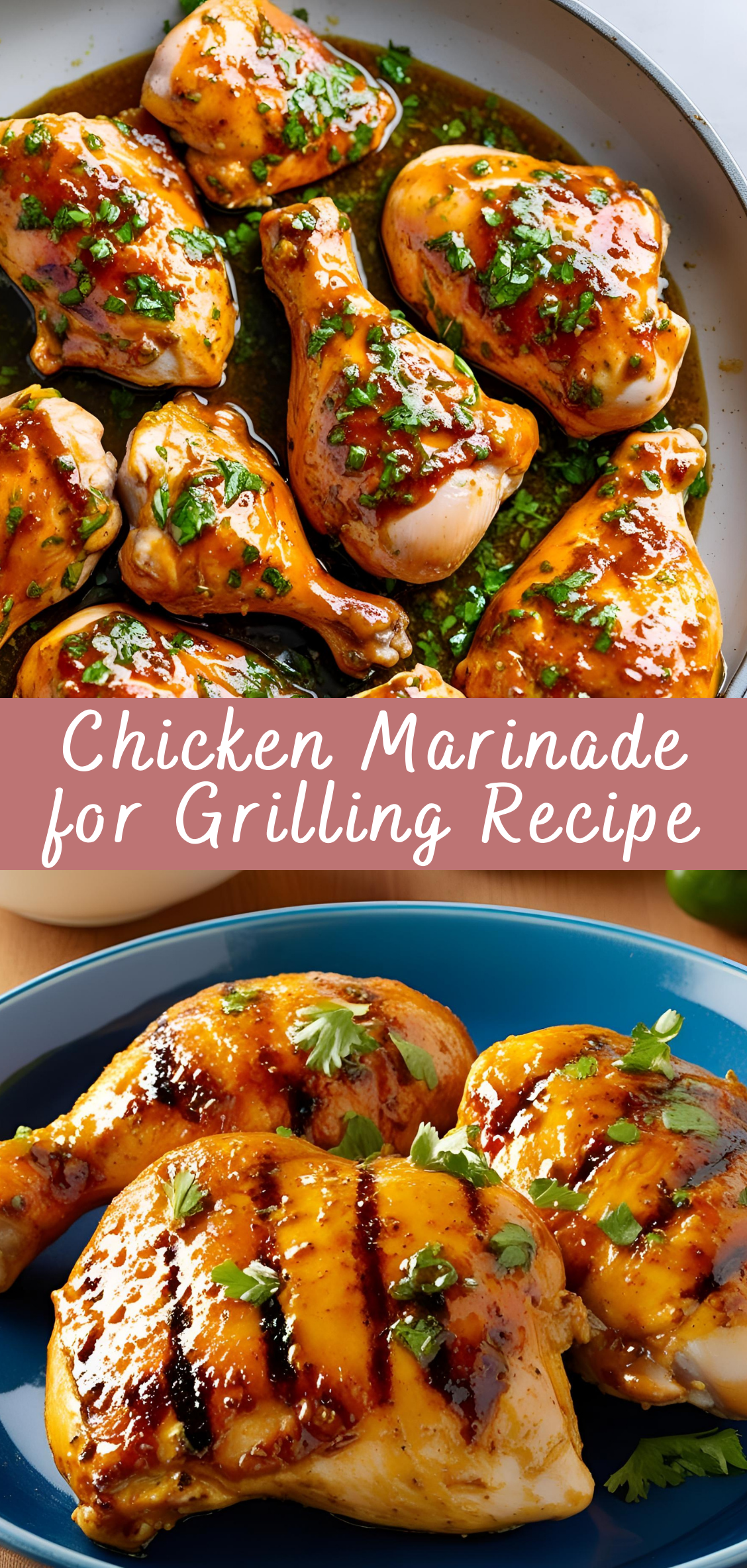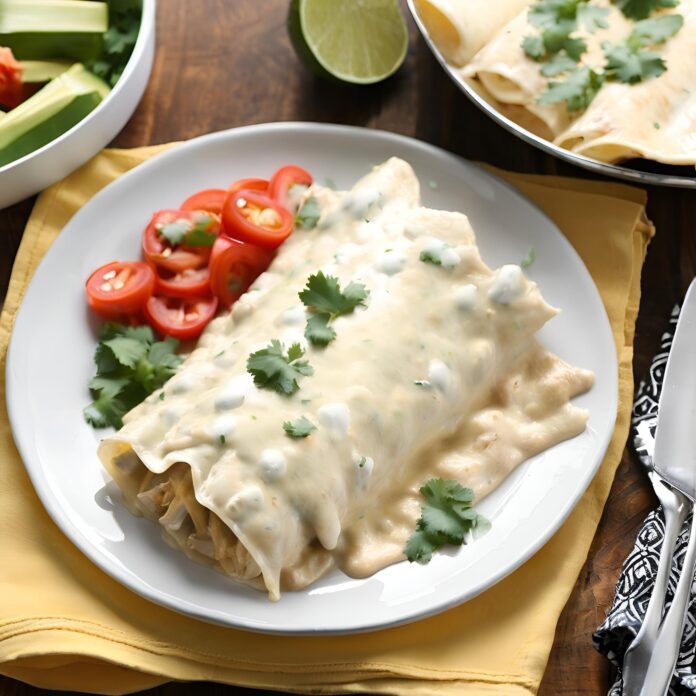Chicken Marinade for Grilling Recipe
Marinades are one of the oldest culinary techniques used to enhance the flavors of food. By soaking meat, vegetables, or even tofu in a flavorful mixture, marinades infuse those ingredients with a depth of taste that transforms an otherwise simple dish into something extraordinary. For grilled chicken, marinating serves several important purposes: it adds flavor, helps tenderize the meat, and locks in moisture, ensuring your chicken comes out juicy, flavorful, and perfectly cooked every time.

Why Marinate Chicken for Grilling?
Grilling chicken is an incredibly popular method of cooking, thanks to the smoky flavor it imparts and the quick cooking time that results in tender, succulent meat. However, chicken breasts, in particular, can sometimes become dry if not properly prepared. This is where marinades come in. When you marinate chicken, you’re not just adding flavor on the surface; you’re ensuring that the seasonings penetrate deep into the meat, creating a more flavorful and tender piece of chicken.
The best part? Marinades are incredibly versatile. They can be sweet, tangy, spicy, or herbaceous, allowing you to customize your grilled chicken to suit your taste or the theme of your meal. Whether you’re craving something smoky and barbecue-inspired or something zesty with citrus and herbs, there’s a marinade for every palate.
What Makes a Great Chicken Marinade?
A great chicken marinade typically includes three key components:
-
Acid: This helps tenderize the meat by breaking down proteins. Common acids used in marinades include citrus juices (like lemon or lime) and yogurt.
-
Fat: Fat is essential for carrying flavors and ensuring the chicken stays moist during cooking. Olive oil, vegetable oil, or even coconut oil can be used to add richness to the marinade.
-
Flavorings: Herbs, spices, and aromatics like garlic, ginger, onion, and chili peppers are what give the marinade its character. Salt and sugar also play an important role in seasoning the meat and enhancing the flavor profile.
Best Practices for Grilling Chicken
Grilling chicken can seem intimidating if you’re new to the process, but with the right techniques and a bit of practice, you can achieve perfectly cooked, juicy, and flavorful grilled chicken every time. Here, we will guide you through some best practices, from preheating the grill to testing for doneness, to ensure that your marinated chicken turns out exactly as you want it.
1. Preheating the Grill
One of the most important steps to grilling is ensuring that your grill is properly preheated. A hot grill helps create an initial sear on the chicken, locking in moisture and preventing the meat from sticking to the grates.
How to Preheat Your Grill:
-
Gas Grill: Turn on the gas and set the burners to medium-high. Close the lid and allow the grill to heat for about 10-15 minutes. You can check the temperature with a grill thermometer, which should read around 400°F-450°F (200°C-230°C).
-
Charcoal Grill: Light the charcoal and let it burn until the coals are covered with a layer of white ash, which typically takes 20-30 minutes. You should aim for a temperature of 350°F-450°F (175°C-230°C). Set up your charcoal for direct or indirect heat depending on how you plan to cook the chicken.
Tip:
For a more even heat distribution, you can arrange the coals in a two-zone setup, with a hotter direct heat side and a cooler indirect heat side. This allows you to sear the chicken over direct heat and then move it to indirect heat to finish cooking.
2. Oiling the Grill Grates
To prevent your chicken from sticking to the grill, it’s important to oil the grates before cooking. You can use a paper towel soaked in vegetable oil or an oil-soaked cloth held with tongs to rub the grill grates. This step will ensure that the chicken releases easily from the grill once it’s cooked.
Tip:
Be careful not to use too much oil, as it could cause flare-ups on a charcoal grill. A light coating is sufficient.
3. Placing the Chicken on the Grill
Once the grill is preheated and the grates are oiled, it’s time to place your marinated chicken on the grill. Here are a few tips for this step:
-
Boneless, Skinless Breasts: These cook relatively quickly, usually in 5-7 minutes per side over medium-high heat. Make sure to flip them only once to ensure even cooking.
-
Bone-In Cuts (Thighs, Drumsticks, or Wings): These require a bit more time to cook through, typically 25-35 minutes depending on the size of the pieces. For bone-in cuts, use the two-zone cooking method (direct and indirect heat). Start by searing the chicken over direct heat, then move it to the indirect heat zone to finish cooking through without burning the outside.
Tip:
If you notice flare-ups or excessive charring, move the chicken to the cooler side of the grill to avoid burning.
4. Grilling Temperatures for Perfectly Cooked Chicken
Grilling times will vary depending on the size of the chicken and the heat of the grill, but internal temperature is the most reliable way to ensure your chicken is cooked through.
Internal Temperature Guidelines:
-
Boneless, Skinless Chicken Breasts: The chicken is done when it reaches an internal temperature of 165°F (74°C).
-
Bone-In Chicken Thighs or Drumsticks: Bone-in cuts need to reach an internal temperature of 170°F-175°F (77°C-80°C) for the best texture and flavor.
Tip:
Investing in a digital meat thermometer is a great way to avoid guesswork. Check the internal temperature by inserting the thermometer into the thickest part of the chicken, avoiding the bone for accurate readings.
5. Flipping the Chicken
One common mistake when grilling chicken is to flip it too often. Flipping the chicken once or twice during grilling is all you need. Frequent flipping can result in uneven cooking and can cause the chicken to dry out.
How to Flip the Chicken:
-
Boneless, Skinless Breasts: Flip after 5-7 minutes, then cook for another 5-7 minutes on the other side.
-
Bone-In Cuts: Sear over direct heat for a few minutes on all sides, then move to indirect heat. Flip every 10-15 minutes until the chicken is fully cooked.
6. Letting the Chicken Rest
Once the chicken has finished grilling, it’s important to let it rest before cutting into it. Resting allows the juices to redistribute within the meat, ensuring that the chicken remains moist and tender.
How Long to Rest the Chicken:
-
Rest the chicken for 5-10 minutes after removing it from the grill. This step is crucial to avoid losing all the juices when you slice into the meat.
Common Mistakes to Avoid
Grilling chicken can be a little tricky, especially when you’re working with marinades. To help ensure that your grilled chicken is tender, juicy, and flavorful, here are some common mistakes to avoid:
1. Over-Marinating the Chicken
While marinating chicken is important, leaving it in the marinade for too long (especially if the marinade is very acidic, like one with lemon or vinegar) can break down the proteins too much, leading to mushy or overly soft chicken. 1-6 hours is generally the sweet spot for marinating chicken. For tougher cuts like thighs or drumsticks, you can marinate overnight.
2. Not Preheating the Grill
Putting chicken on a cold grill can result in uneven cooking. Always preheat your grill to the proper temperature before placing the chicken on it.
3. Not Monitoring the Temperature
Using a meat thermometer is the most reliable way to check the doneness of your chicken. Avoid cutting into the chicken to check for doneness, as this releases juices and leads to dryness.
4. Overcooking the Chicken
Grilling chicken for too long can lead to dry, tough meat. Always watch the cooking time closely, especially with boneless breasts that cook quickly.
Serving Suggestions and Pairings
Once your marinated chicken is grilled to perfection, it’s time to serve it! Here are some delicious serving ideas:
-
Serve with Grilled Vegetables: Pair the chicken with seasonal vegetables like zucchini, bell peppers, or corn on the cob for a balanced and flavorful meal.
-
Toss with a Fresh Salad: Grilled chicken makes an excellent topping for a fresh, vibrant salad. Add some greens, tomatoes, cucumber, and a drizzle of olive oil and balsamic vinegar.
-
Serve with Rice or Quinoa: Pairing grilled chicken with a hearty side like rice or quinoa will make the meal more filling. Consider making a pilaf or a citrus-infused rice dish for added flavor.
-
Wrap in Flatbread: For a quick and easy meal, slice the grilled chicken and wrap it in flatbread with some tzatziki sauce or hummus for a Mediterranean-inspired sandwich.
Chicken Marinade for Grilling Recipe
Marinades are one of the oldest culinary techniques used to enhance the flavors of food. By soaking meat, vegetables, or even tofu in a flavorful mixture, marinades infuse those ingredients with a depth of taste that transforms an otherwise simple dish into something extraordinary. For grilled chicken, marinating serves several important purposes: it adds flavor, helps tenderize the meat, and locks in moisture, ensuring your chicken comes out juicy, flavorful, and perfectly cooked every time.
Ingredients
- 1/4 cup olive oil
- 3 tablespoons lemon juice (about 1 lemon)
- 2 tablespoons soy sauce
- 2 tablespoons Dijon mustard
- 2 cloves garlic, minced
- 1 tablespoon honey or brown sugar (optional, for a touch of sweetness)
- 1 teaspoon dried oregano
- 1 teaspoon dried thyme
- 1/2 teaspoon smoked paprika (optional, for extra flavor)
- 1/2 teaspoon salt
- 1/4 teaspoon black pepper
- 1/4 teaspoon red pepper flakes (optional, for a little heat)
Instructions
- Prepare the Marinade:
In a medium bowl, whisk together olive oil, lemon juice, soy sauce, Dijon mustard, minced garlic, honey (if using), oregano, thyme, smoked paprika, salt, pepper, and red pepper flakes. - Marinate the Chicken:
Place your chicken breasts or thighs in a large resealable plastic bag or shallow dish. Pour the marinade over the chicken, ensuring it’s evenly coated. Seal the bag or cover the dish with plastic wrap. - Refrigerate:
Let the chicken marinate in the refrigerator for at least 30 minutes, but preferably 2–4 hours. The longer the marinating time, the more flavorful the chicken will be. You can even marinate it overnight for maximum flavor. - Preheat the Grill:
Preheat your grill to medium-high heat (about 400°F/200°C). Make sure the grill grates are oiled to prevent sticking. - Grill the Chicken:
Remove the chicken from the marinade and discard any excess marinade. Grill the chicken for about 6–7 minutes per side, or until the internal temperature reaches 165°F (74°C) and the chicken is fully cooked through. - Rest and Serve:
Let the chicken rest for 5 minutes before slicing and serving.
Notes
- Add Extra Flavor: If you'd like, you can add a teaspoon of lemon zest or some fresh chopped herbs (like parsley or cilantro) to the marinade.
- For Juicy Chicken: Make sure not to overcook the chicken. Use a meat thermometer to check the internal temperature to ensure it’s juicy and tender.



